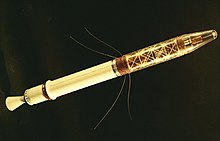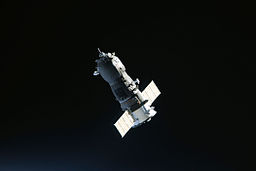Uncrewed spacecraft
This article needs additional citations for verification. (January 2023) |
Bottom: Spaceplane Buran was launched, orbited Earth, and landed as an uncrewed spacecraft in 1988 (left). Model of James Webb Space Telescope (right).
| Part of a series on |
| Spaceflight |
|---|
 |
|
|
Uncrewed spacecraft or robotic spacecraft are
Many space missions are more suited to
The first uncrewed space mission was
Many habitable spacecraft also have varying levels of robotic features. For example, the space stations
History


The first robotic spacecraft was launched by the
Four other such flights were made through the fall of 1951.The first artificial satellite, Sputnik 1, was put into a 215-by-939-kilometer (116 by 507 nmi) Earth orbit by the USSR on 4 October 1957. On 3 November 1957, the USSR orbited Sputnik 2. Weighing 113 kilograms (249 lb), Sputnik 2 carried the first animal into orbit, the dog Laika.[2] Since the satellite was not designed to detach from its launch vehicle's upper stage, the total mass in orbit was 508.3 kilograms (1,121 lb).[3]
In a close race with the Soviets, the United States launched its first artificial satellite, Explorer 1, into a 357-by-2,543-kilometre (193 by 1,373 nmi) orbit on 31 January 1958. Explorer I was an 205-centimetre (80.75 in) long by 15.2-centimetre (6.00 in) diameter cylinder weighing 14.0 kilograms (30.8 lb), compared to Sputnik 1, a 58-centimeter (23 in) sphere which weighed 83.6 kilograms (184 lb). Explorer 1 carried sensors which confirmed the existence of the Van Allen belts, a major scientific discovery at the time, while Sputnik 1 carried no scientific sensors. On 17 March 1958, the US orbited its second satellite, Vanguard 1, which was about the size of a grapefruit, and remains in a 670-by-3,850-kilometre (360 by 2,080 nmi) orbit as of 2016[update].
The first attempted lunar probe was the Luna E-1 No.1, launched on 23 September 1958. The goal of a lunar probe repeatedly failed until 4 January 1959 when Luna 1 orbited around the Moon and then the Sun.
The success of these early missions began a race between the US and the USSR to outdo each other with increasingly ambitious probes. Mariner 2 was the first probe to study another planet, revealing Venus' extremely hot temperature to scientists in 1962, while the Soviet Venera 4 was the first atmospheric probe to study Venus. Mariner 4's 1965 Mars flyby snapped the first images of its cratered surface, which the Soviets responded to a few months later with images from on its surface from Luna 9. In 1967, America's Surveyor 3 gathered information about the Moon's surface that would prove crucial to the Apollo 11 mission that landed humans on the Moon two years later.[4]
The first interstellar probe was Voyager 1, launched 5 September 1977. It entered interstellar space on 25 August 2012,[5] followed by its twin Voyager 2 on 5 November 2018.[6]
Nine other countries have successfully launched satellites using their own launch vehicles: France (1965),[7] Japan[8] and China (1970),[9] the United Kingdom (1971),[10] India (1980),[11] Israel (1988),[12] Iran (2009),[13] North Korea (2012),[14] and South Korea (2022).[15]
Telepresence
Telerobotics becomes telepresence when the time delay is short enough to permit control of the spacecraft in close to real time by humans. Even the two seconds light speed delay for the Moon is too far away for telepresence exploration from Earth. The L1 and L2 positions permit 400-millisecond round trip delays, which is just close enough for telepresence operation. Telepresence has also been suggested as a way to repair satellites in Earth orbit from Earth. The Exploration Telerobotics Symposium in 2012 explored this and other topics.[16]
Design
This section may have too many subsection headers. (May 2023) |
In spacecraft design, the
Subsystems
Structure

The physical backbone structure, which
- provides overall mechanical integrity of the spacecraft
- ensures spacecraft components are supported and can withstand launch loads
Data handling
This is sometimes referred to as the command and data subsystem. It is often responsible for:
- command sequence storage
- maintaining the spacecraft clock
- collecting and reporting spacecraft telemetry data (e.g. spacecraft health)
- collecting and reporting mission data (e.g. photographic images)
Attitude determination and control
This system is mainly responsible for the correct spacecraft's orientation in space (attitude) despite external disturbance-gravity gradient effects, magnetic-field torques, solar radiation and aerodynamic drag; in addition it may be required to reposition movable parts, such as antennas and solar arrays.[19]
Entry, descent, and landing
Integrated sensing incorporates an image transformation algorithm to interpret the immediate imagery land data, perform a real-time detection and avoidance of terrain hazards that may impede safe landing, and increase the accuracy of landing at a desired site of interest using landmark localization techniques. Integrated sensing completes these tasks by relying on pre-recorded information and cameras to understand its location and determine its position and whether it is correct or needs to make any corrections (localization). The cameras are also used to detect any possible hazards whether it is increased fuel consumption or it is a physical hazard such as a poor landing spot in a crater or cliff side that would make landing very not ideal (hazard assessment).
Landing on hazardous terrain
In planetary exploration missions involving robotic spacecraft, there are three key parts in the processes of landing on the surface of the planet to ensure a safe and successful landing.[20] This process includes an entry into the planetary gravity field and atmosphere, a descent through that atmosphere towards an intended/targeted region of scientific value, and a safe landing that guarantees the integrity of the instrumentation on the craft is preserved. While the robotic spacecraft is going through those parts, it must also be capable of estimating its position compared to the surface in order to ensure reliable control of itself and its ability to maneuver well. The robotic spacecraft must also efficiently perform hazard assessment and trajectory adjustments in real time to avoid hazards. To achieve this, the robotic spacecraft requires accurate knowledge of where the spacecraft is located relative to the surface (localization), what may pose as hazards from the terrain (hazard assessment), and where the spacecraft should presently be headed (hazard avoidance). Without the capability for operations for localization, hazard assessment, and avoidance, the robotic spacecraft becomes unsafe and can easily enter dangerous situations such as surface collisions, undesirable fuel consumption levels, and/or unsafe maneuvers.
Telecommunications
Components in the telecommunications subsystem include radio antennas, transmitters and receivers. These may be used to communicate with ground stations on Earth, or with other spacecraft.[21]
Electrical power
The supply of electric power on spacecraft generally come from
Temperature control and protection from the environment
Spacecraft are often protected from temperature fluctuations with insulation. Some spacecraft use mirrors and sunshades for additional protection from solar heating. They also often need shielding from micrometeoroids and orbital debris.[23]
Propulsion
Spacecraft propulsion is a method that allows a spacecraft to travel through space by generating thrust to push it forward.[24] However, there is not one universally used propulsion system: monopropellant, bipropellant, ion propulsion, etc. Each propulsion system generates thrust in slightly different ways with each system having its own advantages and disadvantages. But, most spacecraft propulsion today is based on rocket engines. The general idea behind rocket engines is that when an oxidizer meets the fuel source, there is explosive release of energy and heat at high speeds, which propels the spacecraft forward. This happens due to one basic principle known as Newton's Third Law. According to Newton, "to every action there is an equal and opposite reaction." As the energy and heat is being released from the back of the spacecraft, gas particles are being pushed around to allow the spacecraft to propel forward. The main reason behind the usage of rocket engine today is because rockets are the most powerful form of propulsion there is.
Monopropellant
For a propulsion system to work, there is usually an oxidizer line and a fuel line. This way, the spacecraft propulsion is controlled. But in a monopropellant propulsion, there is no need for an oxidizer line and only requires the fuel line.[25] This works due to the oxidizer being chemically bonded into the fuel molecule itself. But for the propulsion system to be controlled, the combustion of the fuel can only occur due to a presence of a catalyst. This is quite advantageous due to making the rocket engine lighter and cheaper, easy to control, and more reliable. But, the downfall is that the chemical is very dangerous to manufacture, store, and transport.
Bipropellant
A bipropellant propulsion system is a rocket engine that uses a liquid propellent.[26] This means both the oxidizer and fuel line are in liquid states. This system is unique because it requires no ignition system, the two liquids would spontaneously combust as soon as they come into contact with each other and produces the propulsion to push the spacecraft forward. The main benefit for having this technology is because that these kinds of liquids have relatively high density, which allows the volume of the propellent tank to be small, therefore increasing space efficacy. The downside is the same as that of monopropellant propulsion system: very dangerous to manufacture, store, and transport.
Ion
An ion propulsion system is a type of engine that generates thrust by the means of electron bombardment or the acceleration of ions.[27] By shooting high-energy electrons to a propellant atom (neutrally charge), it removes electrons from the propellant atom and this results the propellant atom becoming a positively charged atom. The positively charged ions are guided to pass through positively charged grids that contains thousands of precise aligned holes are running at high voltages. Then, the aligned positively charged ions accelerates through a negative charged accelerator grid that further increases the speed of the ions up to 40 kilometres per second (90,000 mph). The momentum of these positively charged ions provides the thrust to propel the spacecraft forward. The advantage of having this kind of propulsion is that it is incredibly efficient in maintaining constant velocity, which is needed for deep-space travel. However, the amount of thrust produced is extremely low and that it needs a lot of electrical power to operate.
Mechanical devices
Mechanical components often need to be moved for deployment after launch or prior to landing. In addition to the use of motors, many one-time movements are controlled by
Robotic vs. uncrewed spacecraft
Robotic spacecraft are specifically designed system for a specific hostile environment.[29] Due to their specification for a particular environment, it varies greatly in complexity and capabilities. While an uncrewed spacecraft is a spacecraft without personnel or crew and is operated by automatic (proceeds with an action without human intervention) or remote control (with human intervention). The term 'uncrewed spacecraft' does not imply that the spacecraft is robotic.
Control
Robotic spacecraft use






